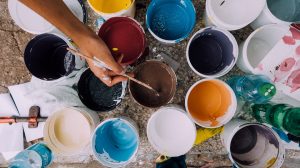The Rublev Colours Zoorn Palette is the most well-known palette for Painters in Brisbane. It was created by Mesoamerican cultures. Although only four colours are included in this palette, it produces an amazing variety of tones. This is particularly useful for landscape painters, as they often work from life. Continue reading to learn more about the history of the colour palettes used by painters and how you can incorporate them into work. Here is an overview of the main types of coloured pigments:
Pigments are used for colouring materials such as cotton, wool and linen. These pigments are made from insoluble mineral powders or coloured lakes. There are many types of paint colours and not all are suitable for use on calico. A calico fabric, for example, cannot use a colour with arsenic as it is toxic. Moreover, some are too muddy or dull to use. Other pigments can tarnish or darken with moisture and exposure to air.

Another important consideration is the color of the paper. Most painters choose paints according to their value and their color. A pastel would look more attractive if it had a darker colour than a yellow. The primary difference between a pastel and a chalk pastel is that a pencil are the same size. A palette of colours is more durable and lasts longer.
To tint fabric, we use pigments. These colours are made from insoluble minerals powders or coloured waters. For calico printing, there are a few varieties of painters’ pigments. Some painters’ colours are not recommended for calico print. Colours containing arsenic, for example, are not recommended. Other types are banned from use because of their high cost. These painters’ pigments may not be as bright as if they were used to make textiles.
Although most painters only use a handful of basic colors, they do have a few favorites. Some of them have many brands of paint. Several of these brands have different colour grades, so the paints will not look identical. These paints may also be available in many different shades. For example, some painters only use warm-toned hues, while some use cool-toned colors.
Temperature-wise, painters are divided into two categories: the primary and the secondary. Primary colors absorb light in the visible spectrum and reflect back to the viewer. Black is the absence any color from the spectrum. A painting that contains all three primary colors will turn out to be dark brown. The primary and second colours can be added to each other. However, mixing them can create a neutral or even complementary colour.
White and black are two of the most important primary colours. These colors are used to highlight the beauty of objects, as well as safety and purity. The primary and secondary colours are also used to create a certain mood in a painting. A painting with black and white in the identical hue can look lifeless. A dark blue painting can be symbolic of death or sadness. Unlike a soft blue, a white painting should be done sparingly.
There are two types of painters’ colours: mineral and modern. These are two different categories of paints, with a few variations in between. The primary colours are derived primarily from minerals such as iron and zinc. This category includes all the pigments that are available for painting. The “organic” or carbon-derived pigments are the modern side. These pigments have a distinct molecular structure which makes them extremely useful in any project.
The colour palette of modern painters is divided into two types: mineral and organic. Both types can bring warmth or coolness into a painting. Bistre, a brown pigment that was made from the inks of cuttlefish, was developed in the 18th-century. This pigment was used by artists in ink painting, illustration, and calligraphy. The seven main colors in the modern painter’s palette are seven. These colors are described as natural or organic.



